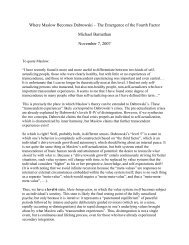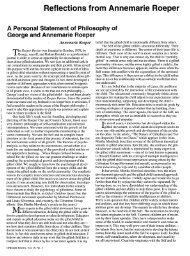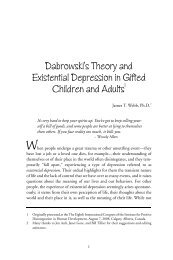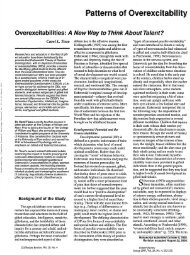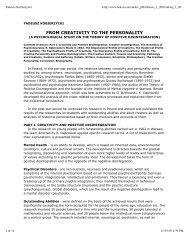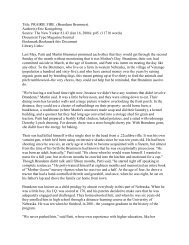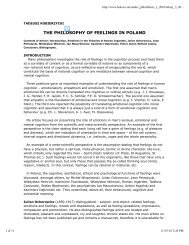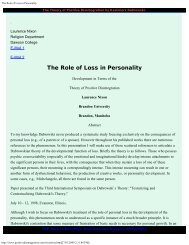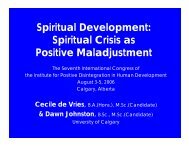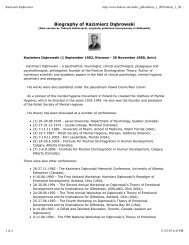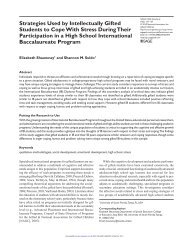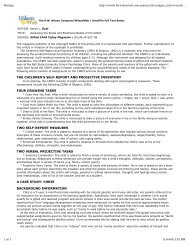Nixon Asian - Kazimierz Dabrowski's Theory of Positive Disintegration
Nixon Asian - Kazimierz Dabrowski's Theory of Positive Disintegration
Nixon Asian - Kazimierz Dabrowski's Theory of Positive Disintegration
You also want an ePaper? Increase the reach of your titles
YUMPU automatically turns print PDFs into web optimized ePapers that Google loves.
<strong>Nixon</strong> <strong>Asian</strong><br />
The <strong>Theory</strong> <strong>of</strong> <strong>Positive</strong> <strong>Disintegration</strong> by <strong>Kazimierz</strong> Dabrowski.<br />
.<br />
Laurence <strong>Nixon</strong><br />
Religion Department<br />
Dawson College<br />
E-Mail 1<br />
E-Mail 2<br />
Reference: <strong>Nixon</strong>, L. (2002). Dabrowski’s Critique <strong>of</strong> <strong>Asian</strong> Religions. In N. Duda, (Ed.). <strong>Positive</strong><br />
<strong>Disintegration</strong>: The <strong>Theory</strong> <strong>of</strong> the future. 100th Dabrowski anniversary program on the man, the<br />
theory, the application and the future. Ft. Lauderdale , FL : Fidlar Doubleday. [The Proceedings from<br />
the Fifth International Conference on the <strong>Theory</strong> <strong>of</strong> <strong>Positive</strong> <strong>Disintegration</strong>, held in Ft. Lauderdale ,<br />
FL., November 7 - 10, 2002 .]<br />
Dabrowski’s Critique <strong>of</strong> <strong>Asian</strong> Religions<br />
Dabrowski makes a number <strong>of</strong> criticisms <strong>of</strong> Hinduism and Buddhism. For example in a work entitled In<br />
search <strong>of</strong> mental health, 1 he says that Eastern religions force a fixed hierarchy <strong>of</strong> values upon<br />
individuals rather than allowing them to discover their own unique hierarchy <strong>of</strong> values.<br />
In the area <strong>of</strong> development <strong>of</strong> our individuality, empathy, responsibility for our own development, our<br />
goals and strivings, Eastern religious systems put us under pressure and force upon us strange views,<br />
a foreign sense <strong>of</strong> life, strange forms <strong>of</strong> love and development, and a strange hierarchy <strong>of</strong> values.<br />
Such transcendence is a construction reminding us <strong>of</strong> an authoritative, absolutist rule <strong>of</strong> bloody<br />
despots, fixed on their own vague visions. It is not we who create these values, nor we who evaluate<br />
the most appropriate for us hierarchies. They are forced upon us, without our participation and choice.<br />
In this manner, we are treated like slaves by “the higher powers.” (1996: somewhere in pp.155-158)<br />
Specifically Zen Buddhism is criticized because it is anti-intellectual and its teachings are vague and<br />
imprecise.<br />
Zen systems are vague; they promote rejection <strong>of</strong> rationality, analysis, discussion and endorse waiting<br />
for some mystical resolutions, which in their pure intuitiveness contradict the higher human nature,<br />
contradict its new creative structure (feelings, desires and intellect). They <strong>of</strong>fer us a cosmos <strong>of</strong><br />
imprecise images, visions <strong>of</strong> unaware existences, consoling us that we will understand these<br />
existences “later.” (1996: somewhere in pp.155-158)<br />
>But at the core <strong>of</strong> Dabrowski’s critique <strong>of</strong> Hindu and Buddhist views <strong>of</strong> the world is the charge that<br />
they are monistic, i.e., that they describe the highest human attainment as a permanent obliteration <strong>of</strong><br />
one’s individual TOP self Back though to Main a merger Page with Brief a larger Overview whole. Glossary Order DVD Bibliography<br />
http://www.positivedisintegration.com/<strong>Nixon</strong>2002Dab%27s%20critique%20<strong>of</strong>%20<strong>Asian</strong>%20Rel.htm[27/01/2009 2:16:56 PM]
<strong>Nixon</strong> <strong>Asian</strong><br />
Presenting, by Buddhism, the highest principle as the moral law, telling us about becoming one (with<br />
God) and the necessary obliteration <strong>of</strong> individual identity, with the simultaneous sentencing a man to a<br />
senseless, ever higher differentiation <strong>of</strong> feelings and consciousness only to cut their roots and turn<br />
man as an individual into nothingness, is promoting the fundamental moral evil and crime against<br />
humanity. Hindu monistic systems, which reject (the survival <strong>of</strong>) the “small personality” (<br />
Radhakrishnan, Vivekananda) while showing the human race the agony <strong>of</strong> reincarnation, acquiring the<br />
subtlest and most individual personality; and which then, against the developmental hierarchy,<br />
sentence it to existence united with God, and so to non-existence – are a dark grotesque, dressed up<br />
in verbal excesses. (1996: somewhere in pp.155-158)<br />
>Dabrowski’s concern about monism is not restricted to a few pages <strong>of</strong> his yet untranslated book<br />
entitled, In search <strong>of</strong> mental health. It can be found also throughout his other writings. Put in a<br />
nutshell, Dabrowski sees monistic religious systems as teaching that individuality will eventually be<br />
obliterated in a permanent union with ultimate reality, thus denying the unique, unrepeatable and<br />
enduring nature <strong>of</strong> the individual and <strong>of</strong> human relationships. Before examining in detail the reasons<br />
for Dabrowski’s concerns about monism, I would like to point out a few facts which will nuance what<br />
Dabrowski has said about <strong>Asian</strong> religions. First, Dabrowski does not object to mystical experiences in<br />
which individual identity is temporarily lost. Second, Dabrowski’s critique <strong>of</strong> <strong>Asian</strong> religion is not<br />
absolute—several practitioners <strong>of</strong> Hinduism and Buddhism are presented as examples <strong>of</strong> advanced<br />
development. Third, Dabrowski does not limit his critique to <strong>Asian</strong> religions alone. And fourth,<br />
Dabrowski allows that it is not only possible, but even likely, that many persons at the level <strong>of</strong><br />
organized multilevel disintegration will hold monist views.<br />
>Individual identity may be temporarily lost in mystical experiences<br />
>It is important not to interpret Dabrowski’s remarks on monism as a rejection <strong>of</strong> those mystical<br />
experiences in which the awareness <strong>of</strong> individual existence is temporarily extinguished. In a passage<br />
critical <strong>of</strong> monism, Dabrowski makes it clear that his criticism does not apply to temporary states <strong>of</strong><br />
identity loss:<br />
Delight, empathy toward another, toward a work <strong>of</strong> art, toward the object <strong>of</strong> love disappear, [without<br />
consciousness <strong>of</strong> one's separateness] ...We are not talking here about a temporary loss <strong>of</strong> one's<br />
sense <strong>of</strong> identity, which makes sense only if it is preceded and followed by states <strong>of</strong> awareness <strong>of</strong><br />
one's identity and uniqueness. (1996: somewhere in pp.125-127)<br />
>Therefore Dabrowski’s comments on monism cannot be interpreted as a rejection <strong>of</strong> the kind <strong>of</strong><br />
experience reported by the Hindu swami Satchidananda, while on a pilgrimage to Mount Kailash in<br />
1958:<br />
We had climbed to a height <strong>of</strong> approximately 13,000 feet when we pitched our camp ... After a light<br />
evening meal, we retired for the night.<br />
http://www.positivedisintegration.com/<strong>Nixon</strong>2002Dab%27s%20critique%20<strong>of</strong>%20<strong>Asian</strong>%20Rel.htm[27/01/2009 2:16:56 PM]
<strong>Nixon</strong> <strong>Asian</strong><br />
As it turned out, I only spent a few minutes in bed. Some unknown force kindled me from within. I<br />
suddenly became aware <strong>of</strong> a pleasant feeling, both within and without, that words cannot express.<br />
Reluctant to stay in the tent, I put on a woolen shawl and left for the shore <strong>of</strong> the lake. There I sat in<br />
meditation. What calmness! What peace! What joy! The Lord blessed me with the wonderful bliss <strong>of</strong><br />
sleep with consciousness [i.e., an experience <strong>of</strong> samadhi]. I lost myself in that bliss.<br />
I did not realize how much time had passed until the first brilliant rays <strong>of</strong> morning sunlight reflected <strong>of</strong>f<br />
the glaciers, piercing my eyelids. The inner light gradually sank back into the heart, while the eyes<br />
became alive to the outer light. The mind, still immersed in the joy <strong>of</strong> the inner light, made the eyes<br />
gently close their lids once more. This gentle tug back and forth between the inner light and the outer<br />
light went on for some time. The ears, which had only heard the inner sound <strong>of</strong> OM in that blissful<br />
state, now became aware <strong>of</strong> the heavy movements <strong>of</strong> men and mules. Little by little I became<br />
conscious <strong>of</strong> the outer world. But even while moving about in the world, that bliss within -- once<br />
experienced -- is never to be forgotten. (Satchidananda, 1984:47-48)<br />
>The swami’s remark that the experience <strong>of</strong> union with the divine, once experienced, is never<br />
forgotten seems to parallel Dabrowski’s description <strong>of</strong> religion at level V, in which he says that<br />
temporary union with God eventually results in a dual awareness <strong>of</strong> an ongoing union with God along<br />
with a simultaneous awareness <strong>of</strong> one’s individual existence:<br />
Active love resulting from experiences gained in meditation and contemplation... Union > with God is<br />
experienced in meditation or in strong intuitive projections, leading to an inner understanding <strong>of</strong> God,<br />
the so-called infused knowledge. The deepest respect and love <strong>of</strong> God do not obliterate the<br />
awareness <strong>of</strong> one’s individuality. This means that the sense <strong>of</strong> affinity and union with God exists<br />
together with preservation <strong>of</strong> distinct and permanent individual essence [emphasis mine]. (1977:217)<br />
Individual practitioners <strong>of</strong> <strong>Asian</strong> religion as examples <strong>of</strong> advanced development<br />
>In his discussion <strong>of</strong> the discipline <strong>of</strong> psychology at different levels, Dabrowski suggests that the<br />
teachings <strong>of</strong> Hindu sages like Sri Aurobindo and Ramakrishna are, along with those <strong>of</strong> Christian saints<br />
like Teresa <strong>of</strong> Avila and Gregory the Great, examples <strong>of</strong> level V psychological thinking (1977:208).<br />
>Ramakrishna is also considered to be, along with Francis <strong>of</strong> Assisi, an example <strong>of</strong> positive infantilism<br />
at level V. Of them Dabrowski says,<br />
... such individuals as Saint Francis <strong>of</strong> Assisi or Ramakrishna combine childlike nature with the highest<br />
level <strong>of</strong> development, guided only by their personality ideal—[which] for Saint Francis is represented<br />
by Christ, [and] for Ramakrishna by [the] Divine Mother Kali. (1977:203)<br />
>Speaking <strong>of</strong> courage that occurs in cases <strong>of</strong> higher level existential anxiety in Psychoneurosis is not<br />
an illness , Dabrowski cites Kierkegaard and the Buddha as examples:<br />
There is a strong concurrence <strong>of</strong> the experiences <strong>of</strong> courage, heroism, humility, fear <strong>of</strong> the unknown<br />
http://www.positivedisintegration.com/<strong>Nixon</strong>2002Dab%27s%20critique%20<strong>of</strong>%20<strong>Asian</strong>%20Rel.htm[27/01/2009 2:16:56 PM]
<strong>Nixon</strong> <strong>Asian</strong><br />
and the decision that one must enter the unknown, as in the case <strong>of</strong> Buddha or Kierkegaard.<br />
(1972a:200)<br />
>The fasting <strong>of</strong> Gandhi and the Vietnamese Buddhist monks (and the self-immolation <strong>of</strong> the<br />
Vietnamese Buddhist monks) are held up as examples <strong>of</strong> frustration (in the form <strong>of</strong> moral protest) at<br />
level V (1977:166).<br />
>Dabrowski, in an account <strong>of</strong> psychiatry at level V, cites yoga as an expression <strong>of</strong> the dynamism <strong>of</strong><br />
self-education:<br />
[At level V] Instead <strong>of</strong> treatment, there is education. The goal for the client is to become capable <strong>of</strong><br />
education-<strong>of</strong>-himself. Various systems and disciplines <strong>of</strong> yoga and self-perfection based on moral and<br />
spiritual principles have this character. (1977:211)<br />
>For a balanced picture <strong>of</strong> Dabrowski’s position on <strong>Asian</strong> religions, it is necessary to take into account<br />
his positive assessment <strong>of</strong> individual Hindus and Buddhists and religious practices like yoga as well as<br />
his rather strongly expressed reservations regarding the dangers <strong>of</strong> <strong>Asian</strong> monism. It is also<br />
necessary to realize that Dabrowski’s critique <strong>of</strong> religious views is not limited to the religions <strong>of</strong> Asia .<br />
Dabrowski’s critique not limited to <strong>Asian</strong> religions ><br />
>Dabrowski is as critical <strong>of</strong> Christian theologians, such as Augustine and Thomas Aquinas, and <strong>of</strong><br />
Catholic mystics such as John <strong>of</strong> the Cross and Thérèse <strong>of</strong> Lisieux, as he is <strong>of</strong> <strong>Asian</strong> religions. A<br />
passage from In search <strong>of</strong> mental health >succinctly states Dabrowski’s objections to Thomism:<br />
St. Thomas in his theology invalidates individual personality, since he dismisses feelings which are<br />
essentially human, and entangles us in ways <strong>of</strong> abstract thought, ways <strong>of</strong> reason, which exclude and<br />
reject all, even the most spiritual individual structures. He creates a vision <strong>of</strong> "unity with God," with a<br />
complete absorption by the deity. (1996:within 155-158)<br />
>And in Fragments from the diary <strong>of</strong> a madman Dabrowski accuses Aquinas <strong>of</strong> rejecting the value <strong>of</strong><br />
emotional love between humans:<br />
According to St. Thomas ’ theology there is no place for differentiated love <strong>of</strong> partners, there is no<br />
place for love from both sides. If love is, it is an “intellectual” one; if will is—it is independent from<br />
feelings and is intellectualized. (1972c:50)<br />
>Dabrowski also finds fault with the view <strong>of</strong> God presented by both Aquinas and Augustine, judging it<br />
to be at a primitive level <strong>of</strong> understanding.<br />
In the history <strong>of</strong> ideas and human experiences concerned with God, we can differentiate three images<br />
and ideas <strong>of</strong> God: [1] an all-powerful lord; [2] a strong and upright being[;] and [3] a God <strong>of</strong> love.<br />
These three phases <strong>of</strong> God go hand in hand with our hierarchy <strong>of</strong> reality, with our image <strong>of</strong> the ideal.<br />
http://www.positivedisintegration.com/<strong>Nixon</strong>2002Dab%27s%20critique%20<strong>of</strong>%20<strong>Asian</strong>%20Rel.htm[27/01/2009 2:16:56 PM]
<strong>Nixon</strong> <strong>Asian</strong><br />
The first idea <strong>of</strong> God was and is most primitive. The last is perhaps the highest level <strong>of</strong> development<br />
and is represented by many ideals in different religions ...<br />
Alas there still exists the first idea <strong>of</strong> God. We can see it in St. Augustine ’s lesson about salvation and<br />
condemnation <strong>of</strong> people. We can see it in St. Thomas ’ picture <strong>of</strong> God as a pure intellect and where<br />
the approach to him is intellectual, an approach which rejects and atrophies emotional attitudes.<br />
(1972c:50)<br />
>To this day Thomas Aquinas remains the dominant theologian in the curriculum <strong>of</strong> Catholic<br />
seminaries and Augustine is a seminal figure not only for the Catholic theological tradition but also for<br />
the Evangelical (or Lutheran) and the Reformed (or Calvinist) traditions. So Dabrowski’s objection to<br />
Thomist and Augustinian theological conceptions is no small matter. Neither is the criticism he makes<br />
<strong>of</strong> John <strong>of</strong> the Cross, a man that most informed Catholics regard as one <strong>of</strong> the most important<br />
theorists in the history <strong>of</strong> Catholic mystical theology. Of John <strong>of</strong> the Cross, Dabrowski says the<br />
following in Fragments from the diary <strong>of</strong> a madman<br />
... St. John <strong>of</strong> the Cross ... elaborates the love <strong>of</strong> God and destroys the differentiated love <strong>of</strong> a man;<br />
he curtails the right for us to possess exclusive feelings for friends and people close to us. Everything<br />
should be given to God; he is rapacious, all-powerful and cannot stand exclusive emotional relations<br />
between people.<br />
How contradictory it is to Christ’s concept that the highest commandment is “love thy neighbour.” God<br />
becomes here an all-powerful, jealous tyrant who demands obedience and which—as a matter <strong>of</strong> fact<br />
—is not interested in the world. And, again, St. John <strong>of</strong> the Cross compensated for this one-sided idea<br />
about God in his poetic and mystical work [which are] full <strong>of</strong> sensuality. (1972c:50-51)<br />
Thérèse > <strong>of</strong> Lisieux is the most popular mystical saint in the modern Catholic church. Dabrowski<br />
considers that the feelings she expressed for God, and which form the basis for her remarkable<br />
popularity with modern Catholics, were a perversion <strong>of</strong> a desire to experience an exclusive [human]<br />
love which she was not allowed to experience. Here are Dabrowski’s own words:<br />
Mistaking elements <strong>of</strong> love for others [can lead] ... to an almost compensated perversion <strong>of</strong> feelings<br />
for God and Christ. We can especially see it in such saints as Thérèse <strong>of</strong> Lisieux who experiences the<br />
having <strong>of</strong> a small Christ in her, or the ceremony <strong>of</strong> getting married to him, calling [him] husband, and<br />
so on.<br />
It is—perhaps—a distorted expression <strong>of</strong> love for God; it is an imposition <strong>of</strong> exclusiveness <strong>of</strong> love for<br />
him [to] whom everything belongs and [for] whom it is necessary to reject everything [else] which,<br />
even though it [may be] ... highly spiritual, is not directed exclusively toward God.<br />
It is a distorted expression <strong>of</strong> the sublimation <strong>of</strong> one’s own primitive egoism, transferring to God the<br />
fanatical desire for exclusive love, impossible to express humanly.<br />
http://www.positivedisintegration.com/<strong>Nixon</strong>2002Dab%27s%20critique%20<strong>of</strong>%20<strong>Asian</strong>%20Rel.htm[27/01/2009 2:16:56 PM]
<strong>Nixon</strong> <strong>Asian</strong><br />
1' There appears, subdued, everything which is perversive even to sexual dreams about God, even to<br />
the feeling <strong>of</strong> having him in the womb, and in the maternal attitude. (1972c:50-51)<br />
>Dabrowski’s knowledge <strong>of</strong> Judaism seems to have been restricted to the existentialist thought <strong>of</strong><br />
Martin Buber, but had he been familiar with the writings <strong>of</strong> Moses Maimonides, rooted as they are in<br />
Aristotelianism, or <strong>of</strong> the neoplatonic mysticism <strong>of</strong> Kabbalah, he would have been as critical <strong>of</strong> these<br />
traditions as he was <strong>of</strong> their Christian counterparts. The point to be made here is simply that<br />
Dabrowski’s criticisms <strong>of</strong> religious thought are in no way uniquely directed toward the <strong>Asian</strong> religious<br />
traditions. Furthermore, in spite <strong>of</strong> his very strong feelings about <strong>Asian</strong> monism, he admits that such<br />
views can be held at a relatively high level <strong>of</strong> personality.<br />
>Level IV monism ><br />
>While Dabrowski strongly disapproves <strong>of</strong> the monist philosophical position, in a discussion <strong>of</strong><br />
philosophy at level IV, he grants that a monist view could be entertained at the level <strong>of</strong> organized<br />
multilevel disintegration, although not beyond this level.<br />
Two directions <strong>of</strong> philosophy emerge as most characteristic for this level: monistic (in the sense <strong>of</strong><br />
accepting total identification with the first cause, the principle <strong>of</strong> being, or the highest being) and<br />
essential (in the sense <strong>of</strong> accepting individual essence as having indestructible existence not to be<br />
dissolved in ultimate oneness). [But there will be a] Gradual transition toward the orientation <strong>of</strong><br />
individual essence. (1977:215)<br />
>At this point, in order to better understand why Dabrowski finds monism so abhorrent, we need to<br />
look at his view <strong>of</strong> the individual, <strong>of</strong> human relationships, <strong>of</strong> immortality and <strong>of</strong> the relationship<br />
between individual humans and ultimate reality.<br />
>Dabrowski’s view <strong>of</strong> the individual<br />
>For Dabrowski each person possesses a unique, authentic and eternal essence as he says in<br />
Existential thoughts and aphorisms:<br />
There is no true human existence without genuine essence. The condition <strong>of</strong> a truly human existence<br />
is awareness <strong>of</strong> and choice <strong>of</strong> what is quintessential, unique and enduring in a man, without which<br />
existence itself would be valueless. (1972b:11)<br />
>In >Fragments from the diary <strong>of</strong> a madman, Dabrowski > explains that individual essence is<br />
emotional and eternal, and it includes unique interests and talents.<br />
If I am an individual, I have needs for identification, development and empathy, if I want to be unique,<br />
unrepeatable, if I want the same for others—that is to say, I want to see them as separate and<br />
unrepeatable—my essence must be emotional.<br />
1' I desire lasting friendship and unrepeatable, unique feelings; I want to have deep interests. The<br />
http://www.positivedisintegration.com/<strong>Nixon</strong>2002Dab%27s%20critique%20<strong>of</strong>%20<strong>Asian</strong>%20Rel.htm[27/01/2009 2:16:56 PM]
<strong>Nixon</strong> <strong>Asian</strong><br />
same talents I now have, in my more or less infantile longing, I want to keep in transcendental life.<br />
1' Essence is a value which I would not renounce because it determines the meaning <strong>of</strong> my life.<br />
Should I have to choose between existence without it and nonexistence, I would choose the second. It<br />
is emotional essence which gives the meaning to existence. (1972c:72-73)<br />
>On the one hand, the basic essence <strong>of</strong> the person seems to be a given, if not from birth, at least from<br />
very early in life. This can be seen by the fact that in the passage just cited, Dabrowski associates<br />
individual essence with “deep interests” and “talents,” and elsewhere he makes it clear that such<br />
interests and talents manifest very early in life:<br />
Developmental potential can also be observed in children in connection with strong special interests<br />
and abilities ... Some children show early mathematical abilities ....<br />
There is a great number <strong>of</strong> children who at age <strong>of</strong> 4-6 write poetry distinguished by deep content and<br />
good form. (1972a:8)<br />
>On the other hand, an authentic human nature is an acquisition attained through effort:<br />
We cannot regard authentism as a gift acquired without work, effort, self-transformation and selfeducation.<br />
Authentism is acquired through deep and grave life experiences, inner conflicts and<br />
unceasing efforts. Therefore, the methods or aids in planning development and self-education must be<br />
based on authentic values, placed in our hierarchy <strong>of</strong> values, progressing from the lowest to the<br />
highest level <strong>of</strong> authentism.<br />
To become authentic—in the sense <strong>of</strong> becoming a unique human individual with an unrepeatable,<br />
autonomously developed social attitude—must be considered one <strong>of</strong> the fundamental elements <strong>of</strong> our<br />
ideal <strong>of</strong> personality... (1973:93-94)<br />
>In other words a person’s unique, eternal emotional essence is discovered through the process <strong>of</strong><br />
positive disintegration and positive secondary integration. Given this understanding <strong>of</strong> human<br />
individuality, it is clear that whatever might threaten it’s existence is a cause for alarm. Going hand in<br />
hand with his understanding <strong>of</strong> human individual essence is Dabrowski’s understanding <strong>of</strong> unique<br />
unrepeatable relationships with significant others.<br />
>Persistent exclusivity <strong>of</strong> friendships and relationships in this world and the next<br />
><br />
>As one might expect, for Dabrowski, friendships and relationships are expressive <strong>of</strong> the<br />
developmental level <strong>of</strong> those involved. So, for example, higher level relationships are characterized by<br />
empathy and the goal <strong>of</strong> mutual encouragement <strong>of</strong> personality development. They are considered<br />
unique and unrepeatable—i.e., not replaceable. Of emotional ties at level IV, Dabrowski says,<br />
Love and friendship take on a spiritual character with common goal <strong>of</strong> self-perfection. The action <strong>of</strong><br />
http://www.positivedisintegration.com/<strong>Nixon</strong>2002Dab%27s%20critique%20<strong>of</strong>%20<strong>Asian</strong>%20Rel.htm[27/01/2009 2:16:56 PM]
<strong>Nixon</strong> <strong>Asian</strong><br />
the dynamisms <strong>of</strong> organized multilevel disintegration, in particular the dynamisms <strong>of</strong> identification and<br />
empathy, constitutes the basis <strong>of</strong> conscious design <strong>of</strong> a developmental program in relation to<br />
exclusive feelings. Emotional ties are more deeply than ever before inderstood as unique and<br />
unrepeatable. (1977:169)<br />
>A cardinal feature <strong>of</strong> friendships and relationships is that they are “exclusive.” This is explicitly stated<br />
by Dabrowski in his description <strong>of</strong> emotional ties at level III:<br />
Emotional ties become more exclusive. There is a distinct need for stability which is realized according<br />
to some general developmental program <strong>of</strong> the individual. The relationships <strong>of</strong> love, friendship, family<br />
are exclusive or almost exclusive. (1977:169)<br />
>Not only are emotional ties exclusive, they are also long-lasting. Dabrowski, speaking <strong>of</strong> higher level<br />
feelings within a marriage says that,<br />
...ideal love with strong individual feeling, and exclusive and unchangeable emotional attachment,<br />
even in conditions <strong>of</strong> fading or loss <strong>of</strong> the partner’s attractive physical features. (1973:122)<br />
>But in Dabrowski’s view this exclusive endurance <strong>of</strong> feeling is not limited to the period when both<br />
persons involved are alive. Authentic emotional ties survive the death <strong>of</strong> one <strong>of</strong> the partners and the<br />
relationship remains an exclusive one, as can be seen from the following passage from The dynamics<br />
<strong>of</strong> concepts:<br />
In some individuals exclusiveness in love is not weakened, although the partners grow older. Love<br />
does not disappear, even after the death <strong>of</strong> one <strong>of</strong> the partners. Although the survivor is still capable<br />
<strong>of</strong> sexual life, he does not remarry and maintains exclusive feelings. (1973:131)<br />
>For Dabrowski, fidelity to a relationship does not end with the grave but continues even after the<br />
partner has died. Furthermore, if the surviving spouse is at a higher level, he or she will not remarry.<br />
This same opinion is expressed in the form <strong>of</strong> a lament in Existential thoughts and aphorisms:<br />
Love, alas, does not pass beyond the grave; it chooses objects <strong>of</strong> this world. What is the meaning <strong>of</strong><br />
eternal individual love? He whose comprehension <strong>of</strong> these matters is different, is always the loser in<br />
competition with the living. (1972b:11)<br />
>Persistent exclusivity is not, in Dabrowski’s view, limited to marital or romantic relationships. In<br />
Fragments from a diary <strong>of</strong> a madman, Dabrowski reflects, in a very personal way, on the persistent<br />
exclusivity <strong>of</strong> friendship at a higher level. Again this reflection takes the form <strong>of</strong> a lament:<br />
I had need <strong>of</strong> emotional exclusiveness.<br />
1' I was terribly disappointed many times. Those to whom I gave my confidence and generosity were<br />
not sincere toward me. My best advice was told to others who did not deserve even a part <strong>of</strong> my<br />
“friend’s” confidence.<br />
http://www.positivedisintegration.com/<strong>Nixon</strong>2002Dab%27s%20critique%20<strong>of</strong>%20<strong>Asian</strong>%20Rel.htm[27/01/2009 2:16:56 PM]
<strong>Nixon</strong> <strong>Asian</strong><br />
1' This easy and superficial “replacement” <strong>of</strong> confidence is the same as unfaithfulness in marriage, it is<br />
like the marriage <strong>of</strong> a widow with an enemy <strong>of</strong> her dead husband. It is like the transition from marriage<br />
or friendship with a truly great man to marriage or friendship with a smaller man. For example,<br />
Hamlet’s mother went from the dignity <strong>of</strong> one marriage to the grotesqueness <strong>of</strong> another.<br />
1' Lack <strong>of</strong> exclusiveness, faithfulness, uniqueness; lack <strong>of</strong> constant relationship, lack <strong>of</strong> sincerity<br />
among friends. I prefer schizophrenic worlds. (1972c:54-55)<br />
>In a passage in Existential thoughts and aphorisms, Dabrowski not only emphasizes post-mortem<br />
fidelity for a meaningful friendship, but even recommends not ever again having such a relationship:<br />
One should remember a close and deceased person as a fresh flower and living wound, but not only<br />
this ... one should live with him as with a person, at least in thought, imagination and longing; one<br />
should create his transcendental form, and if possible—never again have such a close relationship.<br />
(1972b:28)<br />
>Thus in Dabrowski’s view, a person functioning at a higher level will be guided by a moral imperative<br />
to remain faithful to a deceased spouse. But this inclination can be felt in an even more concrete way.<br />
Higher level persons will even lose their ability to function sexually in the absence <strong>of</strong> their spouse.<br />
This is made clear in Dabrowski’s description <strong>of</strong> sexual behaviour at level III:<br />
[At level III] Exclusivity and stability <strong>of</strong> feelings begin to manifest strongly, as well as responsibility for<br />
the partner and the family. In sexual life, emotional components prevail over physical. [The] Sexual<br />
instinct gradually loses its character <strong>of</strong> a biological species drive and becomes an instinct with an<br />
expression individually human. The predominance <strong>of</strong> emotional over physical attachment finds its<br />
expression particularly in the need for exclusivity. Exclusive attachments lead to strong sexual<br />
inhibition, even impotence, when the partner leaves or dies. For example, in my clinical practice, I met<br />
a forty-year old man, father <strong>of</strong> seven children, who became impotent after his wife left him. His<br />
impotence lasted several years until the time when his wife returned to him. This is an example <strong>of</strong> an<br />
inhibition <strong>of</strong> the lower level <strong>of</strong> an instinct (biological level <strong>of</strong> sexual drive) by a higher level <strong>of</strong> the same<br />
instinct (emotional and exclusive attachment).” (1977:79)<br />
>If, at higher levels <strong>of</strong> functioning, there is a tendency to think <strong>of</strong> relationships as persisting beyond the<br />
grave, then it would follow logically that such individuals might spend some <strong>of</strong> their time reflecting on<br />
post-mortem survival. This Dabrowski claims, in his account <strong>of</strong> immortality at level IV, is exactly what<br />
happens:<br />
There is [in persons at level IV an] equal or even stronger interest in the survival <strong>of</strong> others than [in]<br />
one’s own. The subject <strong>of</strong> survival after death is studied and given much thought, particularly the<br />
question <strong>of</strong> those essential qualities which survive. There is a balance between common essence and<br />
individual essence. Love and friendship transcend death. (1977:141)<br />
>Dabrowski proposes, that for some persons at an advanced stage <strong>of</strong> development, there may even<br />
http://www.positivedisintegration.com/<strong>Nixon</strong>2002Dab%27s%20critique%20<strong>of</strong>%20<strong>Asian</strong>%20Rel.htm[27/01/2009 2:16:56 PM]
<strong>Nixon</strong> <strong>Asian</strong><br />
be a willingness to put <strong>of</strong>f until the next world, the actualizing <strong>of</strong> a relationship which exists in this life<br />
only in potential. He cites as an example the case <strong>of</strong> Soren Kirkegaard and Regina Olsen.<br />
[At the level <strong>of</strong> secondary integration] The individual experiences and realizes eternal relationships.<br />
For example, Kierkegaard, in order to preserve the absolute and the ideal aspect <strong>of</strong> his relationship<br />
with Regina , made her believe that he was a scoundrel and was merely playing with her emotions. In<br />
this manner, he made her free <strong>of</strong> her attachment to him. Kierkegaard believed that their union,<br />
impossible on earth, was possible in the absolute. (1977:169-170)<br />
>In Dabrowski’s view, not only is immortality necessary if exclusive, unique and unrepeatable<br />
relationships are to persist, but because there is a need for immortality, there must therefore be such<br />
an immortality. This argument can be found in a passage from In search <strong>of</strong> mental health:<br />
To what conclusions do these thoughts lead us? The structure and strength <strong>of</strong> an individual essence,<br />
and so, among other things, lasting, unique, exclusive love and friendship do not have to fall apart, if<br />
there is any meaning to our existence. Otherwise the highest teachings about the supremacy <strong>of</strong> love,<br />
<strong>of</strong> the utmost importance <strong>of</strong> friendship and love, would be just empty phrases. (1996: somewhere in<br />
pp.135-137)<br />
If there were no immortality, it would not be possible to have the kind <strong>of</strong> relationships which are<br />
characteristic <strong>of</strong> persons at higher levels <strong>of</strong> functioning. Or to put it more precisely, an essential<br />
requirement <strong>of</strong> those relationships—i.e., persistence—would not be possible. But for Dabrowski, not<br />
every type <strong>of</strong> immortality will meet the requirements <strong>of</strong> higher level relationships. It must be an<br />
immortality in which individuals preserve their unique essences. To understand this better we need<br />
now to look at Dabrowski’s understanding <strong>of</strong> the proper relationship between individuals and ultimate<br />
reality, or God.<br />
Dabrowski’s view <strong>of</strong> the relationship with the Absolute<br />
>Dabrowski’s point <strong>of</strong> departure is his understanding <strong>of</strong> the unique nature <strong>of</strong> the human person and <strong>of</strong><br />
human relationships. For Dabrowski both authentic individual existence and authentic human<br />
relationships would be compromised if there were no post-mortem continuity, or if that continuity<br />
consisted in some form <strong>of</strong> obliteration <strong>of</strong> individual identity in a union with the Absolute. This is the<br />
reason for Dabrowski’s unequivocal rejection <strong>of</strong> any form <strong>of</strong> monism, whether it be found in the east or<br />
in the west. Dabrowski’s protest against the monistic interpretation <strong>of</strong> the universe is expressed in<br />
somewhat passionate terms in the following passage from In Search <strong>of</strong> mental health:<br />
If ... [monistic] systems in any way reflect reality, then, in the name <strong>of</strong> human dignity, we cannot<br />
accept them. We should protest against them through our own moral criteria, our empathy, love, our<br />
own sense <strong>of</strong> justice. These systems supposedly show some elements <strong>of</strong> knowledge, express some<br />
kind <strong>of</strong> love. In fact, they do not represent any knowledge or love. (1996: somewhere in pp.155-158)<br />
>Not only would any view that sees the ultimate human goal as a permanent dissolution <strong>of</strong> the self in<br />
http://www.positivedisintegration.com/<strong>Nixon</strong>2002Dab%27s%20critique%20<strong>of</strong>%20<strong>Asian</strong>%20Rel.htm[27/01/2009 2:16:56 PM]
<strong>Nixon</strong> <strong>Asian</strong><br />
a sea <strong>of</strong> divinity be quite unacceptable, the development <strong>of</strong> personality requires that individuals not<br />
identify with anything outside <strong>of</strong> themselves. In The dynamics <strong>of</strong> concepts, Dabrowski puts it as<br />
follows:<br />
Why do we speak on this level about global identification with oneself and not others—I think that it is<br />
[the] only [thing] possible on this level, and it is positive in regard to oneself and the ideal <strong>of</strong><br />
personality. We can have sympathy, love, high regard for others or we can fraternize with others, but<br />
we can’t identify with them. It may be possible for a short period <strong>of</strong> time. Global permanent<br />
identification with others would, not only be pr<strong>of</strong>itless, but destructive <strong>of</strong> our and other’s identity.<br />
We can have love and worship even for god, but we can’t aspire to identification with him because that<br />
is harmful for oneself. From a philosophical point <strong>of</strong> view the author presents a personalistic and antimonistic<br />
attitude. (1973:84-85)<br />
>So what would a higher level relationship with God or the Absolute be like. Dabrowski says that the<br />
religious attitude at level V would be characterized by,<br />
Development <strong>of</strong> the relationship “I” and “Thou” in the sense <strong>of</strong> development <strong>of</strong> absolute religious<br />
values <strong>of</strong> faith together with all-encompassing empathy and universal love. The search for<br />
transcendental hierarchy in religious attitude finds expression in authentism and in idealization <strong>of</strong><br />
personality. Such an attitude develops through an intuitive synthesis <strong>of</strong> one’s own personal<br />
relationship with the divinity. In this level, religious attitude is marked by clarity and simplicity which is<br />
nourished by great depth <strong>of</strong> religious experience. It is also characterized by an effort to make the<br />
relation between immanence and transcendence understandable, to make God a concrete<br />
experience, to carry on with Him a dialogue in place <strong>of</strong> his monologue. There may occur breaks and<br />
interruptions in such a dialogue leading to the “dark night <strong>of</strong> the soul,” but the need and search for the<br />
dialogue remain intact and unassailable. (1977:143-144)<br />
>For Dabrowski the type <strong>of</strong> relationship that Buber calls an I-Thou relationship is what chatacterizes<br />
religious experience at level V. Only this kind <strong>of</strong> relationship, he feels, will preserve the important<br />
achievements <strong>of</strong> someone who has arrived at an advanced level <strong>of</strong> personality. And only this kind <strong>of</strong><br />
relationship will allow for the persistence <strong>of</strong> intimate friendships and relationships.<br />
>Dabrowski’s accusation that most Hindu and Buddhist schools are monists<br />
>Dabrowski is under the impression, and here we have to take into account, the nature <strong>of</strong> his sources,<br />
that most forms <strong>of</strong> Hinduism and Buddhism, and by implication, most Hindus and Buddhists are<br />
monists—i.e., that in one way or another they deny the eternal existence <strong>of</strong> an authentic individual<br />
essence.<br />
Hindu and Buddhist philosophies, and esoteric systems, most <strong>of</strong>ten express monistic views.<br />
[emphasis mine] (1996: somewhere in pp.135-137)<br />
http://www.positivedisintegration.com/<strong>Nixon</strong>2002Dab%27s%20critique%20<strong>of</strong>%20<strong>Asian</strong>%20Rel.htm[27/01/2009 2:16:56 PM]
<strong>Nixon</strong> <strong>Asian</strong><br />
Awareness <strong>of</strong> all that is important to us, exclusive and unrepeatable; and what is deep, authentic,<br />
inviolable in others; authentic awareness in others and oneself constitute this kind <strong>of</strong> consciousness<br />
which is the consciousness <strong>of</strong> one's personality and self-determination. A majority <strong>of</strong> Hindu, Buddhist,<br />
Zen, Tibetan, and even scholastic systems are opposed to this approach. [emphasis mine] (1996:<br />
somewhere in pp.125-127)<br />
>The fact <strong>of</strong> the matter is that most Hindus and Buddhists believe in a self that endures beyond the<br />
grave, as we shall now see.<br />
>Are most Hindus monists? ><br />
>The Hindu philosophical tradition is a very rich one and includes a number <strong>of</strong> schools. Since the<br />
medieval period the most widespread (both in India and abroad) <strong>of</strong> these schools is the one known as<br />
Vedanta, about which the Hinduism scholar, Cybelle Shattuck, says the following:<br />
Vedanta, [which means] the “end <strong>of</strong> the Vedas [the most ancient Hindu texts]” is the name given to<br />
the most influential philosophy from the medieval period. There are actually several distinct schools<br />
within Vedanta, each with its own great teachers and doctrines. The core focus <strong>of</strong> these schools is the<br />
understanding <strong>of</strong> the relationship between Brahman [the supreme being] and atman [the soul]...<br />
(Shattuck, 1999:56)<br />
>The sub-system <strong>of</strong> Vedanta known as Advaita Vedanta (or non-dual Vedanta) is the one that fits<br />
Dabrowski’s stereotype <strong>of</strong> Hindu monism. Shattuck describes it as follows:<br />
The Vedanta most familiar in the West is associated with Shankara (c. 788-820 C.E.) ... who ...<br />
described Brahman [or the supernatural] as non-dual. There is only one reality and that is Brahman.<br />
The individual atman [or soul] is identical to Brahman ... but people see themselves as distinct entities<br />
in a world <strong>of</strong> diverse forms because <strong>of</strong> maya, “illusion.” When that illusion is pierced, one realizes that<br />
there is nothing but Brahman. The cycle <strong>of</strong> rebirth [i.e., reincarnation] ceases and, at death, the<br />
individual atman merges into Brahman. (Shattuck, 1999:56-58)<br />
>Shattuck explains that this form <strong>of</strong> Hindu monism was meant for a rather limited audience, i.e., Hindu<br />
monastics. Hindu lay persons are almost always dualists:<br />
Shankara’s system, which was not designed for householder life [but rather for monastics] and [which]<br />
demoted theistic devotion, is far less representative <strong>of</strong> majority Hinduism than the teachings <strong>of</strong><br />
Ramanuja. Ramanuja (c. 1025-1137) utilized the theism <strong>of</strong> the medieval literature in his interpretation<br />
<strong>of</strong> the Vedanta texts to formulate the school known as Vishishta-advaita , “qualified non-dualism” [in<br />
which] ... the supreme Brahman is the personal Lord ... Brahman is the ground <strong>of</strong> existence, but<br />
individual souls and matter are eternally distinct parts <strong>of</strong> Brahman. So, although Brahman is<br />
everything, and therefore non-dual, that non-dualism is qualified by the distinct existence <strong>of</strong> souls and<br />
matter. (Shattuck, 1999:58)<br />
http://www.positivedisintegration.com/<strong>Nixon</strong>2002Dab%27s%20critique%20<strong>of</strong>%20<strong>Asian</strong>%20Rel.htm[27/01/2009 2:16:56 PM]
<strong>Nixon</strong> <strong>Asian</strong><br />
>This means that for the vast majority <strong>of</strong> Hindus,<br />
... the world is real and souls retain their individuality even in [spiritual] liberation [i.e., in eternity] ...<br />
Ramanuja describes this devotion as self-surrender and constant contemplation <strong>of</strong> God. [And] This<br />
Brahman is a personal God [and] ... There must be a distinction between the soul and God to make [a]<br />
... relationship possible. [For Ramanuja] ... the experience <strong>of</strong> the atman merging into the attributeless<br />
Brahman (which is the highest attainment <strong>of</strong> Advaita Vedanta) is a preliminary stage <strong>of</strong> purification<br />
before the self regains a sense <strong>of</strong> personal identity and passes on to attain a higher stage <strong>of</strong><br />
permanent communion with the personal Lord. (Shattuck, 1999:58-59)<br />
>From Shattuck’s remarks it would seem that ordinary Hindu lay persons, or householders, are nonmonistic,<br />
whereas the Hindu monastics are monistic. In fact, however even the ascetics are not<br />
exclusively monistic—there are both non-monistic and monistic ascetics.<br />
>In a study <strong>of</strong> ascetics living in the city <strong>of</strong> Bhubaneswar (in the state <strong>of</strong> Orissa) David Miller lists the<br />
various mathas (or monasteries) to be found in that location (Miller, 1976: Table 18). Ten <strong>of</strong> the 22<br />
mathas followed, at least nominally, the teachings <strong>of</strong> Shankara, the eighth-century founder <strong>of</strong> the best<br />
known form <strong>of</strong> Hindu monism. The other twelve, <strong>of</strong> the 22 monasteries, followed the theistic teachings<br />
<strong>of</strong> Shankara’s rivals (Ramanuja and Madhva). These statistics, if typical, would make it seem as if<br />
almost half <strong>of</strong> the Hindu ascetics are monistic in their beliefs. But the matter is somewhat more<br />
complex. In spite <strong>of</strong> belonging to a monistic religious order an ascetic usually engages in devotions to<br />
a personal god and at the same time encourages others to do so. Miller cites the case <strong>of</strong> an ascetic<br />
named Jagadananda who received lay initiation from a guru at the age <strong>of</strong> 17 years and then for ten<br />
years was torn between worldly life and a desire to experience samadhi [spiritual liberation]. Finally at<br />
the age <strong>of</strong> 27 he committed himself to the ascetical life by joining one <strong>of</strong> the monistic religious orders<br />
founded by Shankara (Miller, 1976:31). However in spite <strong>of</strong> this affiliation, Miller tells us that<br />
Philosophically, Jagadananda was a syncretist and an eclectic. He believed that karma yoga [or<br />
Brahmanic ritual performance], bhakti yoga [devotion to personal deities], and jñana yoga [the<br />
meditative study <strong>of</strong> monistic mystical texts] were equally important paths to the same goal. (Miller,<br />
1976: 33)<br />
Jagadananda’s case is not atypical. In spite <strong>of</strong> belonging to a monistic religious order, an ascetic may<br />
personally understand, and teach others, that the way to relate to the supernatural is by entering into a<br />
(unique, unrepeatable and eternal) relationship with a personal deity—a relationship in which the<br />
worshipper does not lose his or her individual identity.<br />
>Are most Buddhists monists?<br />
>What Cybelle Shattuck has said about the majority <strong>of</strong> Hindus, is equally true <strong>of</strong> the majority <strong>of</strong><br />
Buddhists. There are two major divisions <strong>of</strong> Buddhists. One <strong>of</strong> these is Theravada, found mostly in Sri<br />
Lanka, and the southeast <strong>Asian</strong> countries <strong>of</strong> Burma, Laos, Thailand and Cambodia, and through<br />
immigration (and to a lesser extent conversion) in many other parts <strong>of</strong> the world, such as North<br />
http://www.positivedisintegration.com/<strong>Nixon</strong>2002Dab%27s%20critique%20<strong>of</strong>%20<strong>Asian</strong>%20Rel.htm[27/01/2009 2:16:56 PM]
<strong>Nixon</strong> <strong>Asian</strong><br />
America. The second branch is Mahayana, found mainly in China >, Vietnam , Korea and Japan , and<br />
once again as a result <strong>of</strong> immigration in many other parts <strong>of</strong> the world.<br />
>Both branches <strong>of</strong> Buddhism can be thought <strong>of</strong> as monistic, in the sense that Dabrowski finds<br />
objectionable, because they have in common beliefs in impermanence, soullessness and the ultimate<br />
“emptiness” <strong>of</strong> existence. At least these concepts are part <strong>of</strong> the <strong>of</strong>ficial teaching. It is a different<br />
matter altogether at the popular level.<br />
>In his classic study <strong>of</strong> Buddhism in a Burmese village, Melford Spiro found that there was not just<br />
one form <strong>of</strong> Buddhism but at least three forms. These could even be seen as three levels <strong>of</strong><br />
Buddhism. The first level could be referred to as the material level, in which practitioners hope to be<br />
relieved <strong>of</strong> daily problems and have the needs <strong>of</strong> this world satisfied. The second level is one in which<br />
adherents hope for a better rebirth. Spiro found that these two goals were the only ones that were<br />
relevant for the vast majority <strong>of</strong> Burmese Buddhists. Only a few forest monks had as their goal the<br />
immediate attainment <strong>of</strong> nirvana, in which the illusion <strong>of</strong> a permanent self would be overcome. Spiro<br />
found that while the non-self doctrine was held by forest monks, this was not the case for the majority<br />
<strong>of</strong> Burmese Buddhists, who are anticipating a happier rebirth.<br />
Burmans ... not only reject the concept <strong>of</strong> nonself, but many <strong>of</strong> them, including the most<br />
knowledgeable Buddhists in Yeigyi [the village where Spiro did his field work] do not even know its<br />
meaning. (Spiro, 1970:84-85)<br />
For most Burmese concerned with merit and karma, the belief in a permanent ego which survives the<br />
death <strong>of</strong> the body is both a psychological necessity and a moral imperative. The psychological<br />
necessity follows from their hope to achieve a better and avoid an unpleasant rebirth. Without the<br />
notion <strong>of</strong> a permanent ego persisting from one rebirth to the next, this hope (so they argue) would be<br />
irrelevant, the belief in karma would lose its motivational significance, and behavior would lose its<br />
religious (Buddhist) underpinning. (Spiro, 1970:86)<br />
>The same distinction that Spiro found among Theravada Buddhists can also be found in the<br />
Mahayana school. This branch <strong>of</strong> Buddhism is made up primarily <strong>of</strong> two sects—i.e., Ch’an and Chingt’u.<br />
The fist is better known in the west as Zen (which simply means meditation) and is the form <strong>of</strong><br />
Mahayana Buddhism practised by monks and nuns. The second sect, Ching-t’u, or Pure Land , is the<br />
form <strong>of</strong> Mahayana Buddhism practised by the overwhelming majority <strong>of</strong> Chinese, Vietnamese, Korean<br />
and Japanese Buddhists. The goal <strong>of</strong> Pure Land Buddhists is, at the end <strong>of</strong> their lives, to enter (as<br />
unique individual souls) into a heavenly realm where they will live in relationship with O-mi-to- fo, the<br />
heavenly Buddha.<br />
>At the popular level then, the majority <strong>of</strong> Hindus and Buddhists think more or less along the lines <strong>of</strong><br />
Dabrowski. They expect to survive as unique, unrepeatable selves, eventually enjoying an eternal<br />
relationship to the supernatural conceived <strong>of</strong> in anthropomorphic terms, or in the case <strong>of</strong> the<br />
Theravadin Buddhists, they look forward to a better future life on earth. However, even if most Hindus<br />
http://www.positivedisintegration.com/<strong>Nixon</strong>2002Dab%27s%20critique%20<strong>of</strong>%20<strong>Asian</strong>%20Rel.htm[27/01/2009 2:16:56 PM]
<strong>Nixon</strong> <strong>Asian</strong><br />
and Buddhists see themselves as having a continued existence in a manner that is not in striking<br />
opposition to Dabrowski’s understanding <strong>of</strong> immortality, what <strong>of</strong> the many sophisticated and highly<br />
regarded representatives <strong>of</strong> those traditions who espouse views that do appear to be what Dabrowski<br />
refers to as “monistic.” This is especially true <strong>of</strong> Buddhism, with its doctrines <strong>of</strong> impermanence,<br />
soullessness and ultimate emptiness. Time does not permit a detailed (and adequate) presentation <strong>of</strong><br />
Buddhist teaching on these topics, but perhaps a few words can be said about one <strong>of</strong> them—namely<br />
the Buddhist view <strong>of</strong> the self. At a purely literal level it would seem that Dabrowski’s ideal <strong>of</strong> a real,<br />
unique, enduring individual essence is completely opposed by the Buddhist notion <strong>of</strong> anatman or<br />
soullessness. However I believe that when we look more closely at the matter, the opposition is not so<br />
obvious.<br />
>Buddhist selflessness and the theory <strong>of</strong> positive disintegration<br />
It is essential to realize that when Buddhists speak <strong>of</strong> selflessness, they are not referring to what<br />
Dabrowski calls the individual’s unique, unrepeatable essence. Rather when they refer to the illusion<br />
<strong>of</strong> a permanent self, they have in mind the various senses <strong>of</strong> self which Dabrowski calls lower level<br />
drives, impulses, wills or centers. For Dabrowski the true individual essence is found only in the<br />
personality ideal and in Buddhist teaching there is an equivalent, which is referred to as one’s true<br />
nature or one’s Buddha nature.<br />
The source on the Buddhist notion <strong>of</strong> selflessness and Buddha nature that I will cite here is a North<br />
American named Jack Kornfield. Kornfield spent many years in Sri Lanka and southeast Asia<br />
practicing meditation and learning from well-respected Buddhist teachers. Unlike most <strong>of</strong> Dabrowski’s<br />
sources on <strong>Asian</strong> religion, he is both a scholar and a serious practitioner. In A path with heart,<br />
Kornfield provides his readers with the following description <strong>of</strong> the Buddhist doctrine <strong>of</strong> selflessness:<br />
... the Buddha ... described us as a collection <strong>of</strong> five changing processes: the process <strong>of</strong> the physical<br />
body, <strong>of</strong> feelings, <strong>of</strong> perceptions, <strong>of</strong> responses, and <strong>of</strong> the flow <strong>of</strong> consciousness that experiences<br />
them all. Our sense <strong>of</strong> self arises whenever we grasp at or identify with these patterns. The process <strong>of</strong><br />
identification, <strong>of</strong> selecting patterns to call “I,” “me,” “myself,” is subtle and usually hidden from our<br />
awareness. We can identify with our body, feelings, or thoughts; we can identify with images, patterns,<br />
roles, and archetypes. Thus ... we might fix and identify with the role <strong>of</strong> being a woman or a man, a<br />
parent or a child ... Sometimes we identify with our desires: sexual, aesthetic, or spiritual ... We can<br />
choose the archetype <strong>of</strong> hero, lover, mother, ... adventurer, clown, or thief as our identity ... To the<br />
extent that we grasp these false identities, we continually have to protect and defend ourselves, strive<br />
to fulfill what is limited or deficient in them, to fear their loss.<br />
Yet these are not our true identity. (Kornfield, 1993:199)<br />
The patterns Kornfield describes are not unlike the ones that Dabrowski identifies when he describes<br />
the sense <strong>of</strong> self possessed by persons in primary integration, unilevel disintegration and even<br />
spontaneous multilevel disintegration. In other words when Buddhists make use <strong>of</strong> the doctrine <strong>of</strong><br />
http://www.positivedisintegration.com/<strong>Nixon</strong>2002Dab%27s%20critique%20<strong>of</strong>%20<strong>Asian</strong>%20Rel.htm[27/01/2009 2:16:56 PM]
<strong>Nixon</strong> <strong>Asian</strong><br />
selflessness in their practice, the purpose is to encourage practitioners to relinquish identification with<br />
lower level conceptions <strong>of</strong> who they are, i.e., they are encouraged to relinquish identification with the<br />
“primitive drives and instincts” <strong>of</strong> primary integration (Dabrowski & Piechowski, 1977:40); with the<br />
“influences directing behavior ... from external sources, or desires, moods and primitive drives” <strong>of</strong><br />
unilevel disintegration (Dabrowski & Piechowski, 1977:48-49); and, at the appropriate point, even the<br />
“various disposing and directing centers, representing antagonistic levels,” <strong>of</strong> spontaneous multilevel<br />
disintegration (Dabrowski & Piechowski, 1977:42).<br />
In a passage, on the disposing and directing centre, in The dynamics <strong>of</strong> concepts, Dabrowski says<br />
that, as the personality develops, lower level identifications (or conceptions <strong>of</strong> the self) disintegrate<br />
and are eventually replaced by a higher unified disposing and directing center.<br />
We may say that at ... [the] stage [<strong>of</strong> unilevel disintegration] there are many changeable, conflicting or<br />
cooperating centers <strong>of</strong> the same level <strong>of</strong> development. We may also speak <strong>of</strong> the activity <strong>of</strong> some or<br />
many “wills” as centers which alternately oppose or cooperate with one another.<br />
When the development <strong>of</strong> the human individual is passing to the third phase—the phase <strong>of</strong> multilevel,<br />
spontaneous disintegration—these centers become less numerous, less differentiated in power and<br />
tension. The centers which represent hierarchically lower levels submit to the centers which represent<br />
higher levels. In this hierarchicalization all the dynamisms <strong>of</strong> the third phase <strong>of</strong> multilevel<br />
disintegration take part ... Those dynamisms which slowly disintegrate themselves into one disposing<br />
and directing center, slowly gain ground. However this center does not yet operate in a definite and<br />
clear manner.<br />
It is only in the fourth stage <strong>of</strong> disintegration that one center is definitely formed and that it acts<br />
synthetically as one center on a high level.<br />
On the highest level ... we have only one disposing and directing center which synthesizes intuitively<br />
all human tendencies. (Dabrowski, 1973:102-103)<br />
Thus, in terms <strong>of</strong> the theory <strong>of</strong> positive disintegration, growth requires the practice <strong>of</strong> something<br />
analogous to selflessness, at least with regard to lower level “wills,” or “centers,” i.e., lower level<br />
conceptions <strong>of</strong> the self. Dabrowski does not, <strong>of</strong> course, say that the disintegration <strong>of</strong> these wills or<br />
centers, will be replaced by a vacuum, but that a center (or set <strong>of</strong> centers) will be replaced by a higher<br />
set. Kornfield likewise is not suggesting that persons should have no disposing and directing center.<br />
He is aware that some may think this way, but he makes it clear that such a conception is a<br />
misunderstanding <strong>of</strong> what is meant by selflessness.<br />
Misconceptions about selflessness and emptiness abound ....<br />
1' Many students come to [Buddhist] spiritual practice with ... [the] problem some psychologists call a<br />
“weak sense <strong>of</strong> self” or a “needy ego,” with holes in their psyche or heart. This deficient sense <strong>of</strong> self<br />
is carried for years by our habits and bodily contractions, by the stories and mental images we have<br />
http://www.positivedisintegration.com/<strong>Nixon</strong>2002Dab%27s%20critique%20<strong>of</strong>%20<strong>Asian</strong>%20Rel.htm[27/01/2009 2:16:56 PM]
<strong>Nixon</strong> <strong>Asian</strong><br />
learned and tell ourselves. If we have a deficient sense <strong>of</strong> self, if we perennially negate ourselves, then<br />
we may easily confuse our inner poverty with selflessness and believe it to be sanctioned as the road<br />
to enlightenment ....<br />
1' Similar confusion happens when “emptiness” is misunderstood as “meaninglessness.” This<br />
misperception can reinforce our underlying depression and fear <strong>of</strong> the world, justifying our inability to<br />
find beauty or lack <strong>of</strong> motivation to participate in life. (Kornfield, 1993:203-204)<br />
Furthermore Kornfield says that dissolving an inadequate conception <strong>of</strong> self is only part <strong>of</strong> the task <strong>of</strong><br />
a Buddhist practitioner, the other side is for the individual to discover his or her true nature, or his or<br />
her Buddha nature.<br />
Dissolving the sense <strong>of</strong> self or experiencing the selfless nature <strong>of</strong> life is only one side <strong>of</strong> the coin ... the<br />
other is to develop a healthy sense <strong>of</strong> self .... When we have reclaimed some measure <strong>of</strong> ourselves,<br />
the next task becomes the further development <strong>of</strong> character, <strong>of</strong> our wisdom, strength, skill, and<br />
compassion ... the cultivation <strong>of</strong> ... qualities such as generosity, patience, mindfulness, and kindness.<br />
1' The development <strong>of</strong> self then leads to a more fundamental level, the discovery <strong>of</strong> the true self. This<br />
is the discovery that the positive qualities <strong>of</strong> character that spiritual life works so hard to cultivate are<br />
already present as our true nature. From this sense <strong>of</strong> true nature, we can also discover and honor our<br />
individual or personal destiny ... the unique patterns through which our awakening will express itself.<br />
(Kornfield, 1993:207)<br />
For Dabrowski the ultimate goal <strong>of</strong> personality development is that the disposing and directing center<br />
becomes “totally unified and identified with the personality ideal” (Dabrowski & Piechowski, 1977:56).<br />
Kornfield’s description <strong>of</strong> the true self appears to be close to what Dabrowski refers to as the<br />
personality ideal.<br />
What is so interesting is that Kornfield emphasizes the unique, unrepeatable and personal character<br />
<strong>of</strong> the Buddha nature. Here is what he has to say:<br />
In awakening our Buddha nature, we find that there is one further aspect <strong>of</strong> self to understand, the<br />
need to honor our personal destiny ....<br />
1' The universal qualities <strong>of</strong> our Buddha nature must shine through each <strong>of</strong> us, evolving out <strong>of</strong> the<br />
individual set <strong>of</strong> patterns in each person. This unique set <strong>of</strong> patterns we could call our character, our<br />
destiny, our individual path to fulfill. To discover our destiny is to sense wisely the potential <strong>of</strong> our<br />
individual life and the tasks necessary to fulfill it. To do so is to open to the mystery <strong>of</strong> our individual<br />
incarnation .... To sense the patterns and gifts given to us and to fulfill them is a wondrous part <strong>of</strong> the<br />
development <strong>of</strong> self. It is an honoring <strong>of</strong> our potential and our unique destiny. In this we can bring<br />
together our practice, our particular tasks in our family and community, fulfilling our capacities, our<br />
gifts, and our heart as a unique individual. As we do so, our individual nature reflects the universal.<br />
http://www.positivedisintegration.com/<strong>Nixon</strong>2002Dab%27s%20critique%20<strong>of</strong>%20<strong>Asian</strong>%20Rel.htm[27/01/2009 2:16:56 PM]
<strong>Nixon</strong> <strong>Asian</strong><br />
1' Then when these qualities <strong>of</strong> the Buddha nature and personal self are combined with a deep<br />
realization <strong>of</strong> the emptiness <strong>of</strong> the self, we can be said to have fully discovered the nature <strong>of</strong> the self.<br />
This true self is both unique and universal. (Kornfield, 1993:211-212)<br />
Not only does Kornfield argue that the Buddhist understanding <strong>of</strong> a person’s true nature is an<br />
individual one with its own patterns, gifts and destiny but he further claims that, once enlightened, this<br />
unique self, far from being absorbed into an empty void, co-exists with a universal absolute.<br />
Kornfield’s description <strong>of</strong> the coexistence <strong>of</strong> a unique individual true nature with a larger allencompassing<br />
universal is, at least to some extent, parallel to Dabrowski’s description <strong>of</strong> this<br />
relationship in religion at secondary integration. Religion at level V, Dabrowski says, has the following<br />
character:<br />
Union with God is experienced in meditation or in strong intuitive projections, leading to an inner<br />
understanding <strong>of</strong> God, the so-called infused knowledge. The deepest respect and love <strong>of</strong> God do not<br />
obliterate the awareness <strong>of</strong> one’s individuality. This means that the sense <strong>of</strong> affinity and union with<br />
God exists together with preservation <strong>of</strong> distinct permanent essence. (Dabrowski & Piechowski,<br />
1977:217)<br />
None <strong>of</strong> this is to say that the Buddhist understanding, <strong>of</strong> personal development and destiny, are<br />
identical to the views <strong>of</strong> Dabrowski—simply to suggest that the differences may not be as great as<br />
Dabrowski imagined them to be.<br />
>Making a distinction between empirical psychology and theology<br />
>Finally in closing I would like to raise another, and in a way, more fundamental, point. It is difficult to<br />
separate Dabrowski’s empirically based psychological theory from his metaphysical speculations, but<br />
the distinction must be made. Not everyone who is attracted to the theory <strong>of</strong> positive disintegration will<br />
be inclined toward Kierkegaardian religious existentialism, or necessarily toward any religious<br />
perspective at all. Dabrowski had no need <strong>of</strong> such distinctions himself—both his psychological insights<br />
and his metaphysical beliefs proceeded as interconnected parts <strong>of</strong> a whole from his own unique<br />
individual essence. However if the theory <strong>of</strong> positive disintegration is to gain wide acceptance, and<br />
there are very good reasons why it should, then, it seems to me that a distinction must be made<br />
between the theory <strong>of</strong> personality development, as such, and Dabrowski’s personal metaphysical<br />
views. A psychological theory which claims to be empirically based is assessed by very different<br />
criteria than those used to interpret, compare, and evaluate the various theological or metaphysical<br />
positions <strong>of</strong> the world’s religious traditions.<br />
Note<br />
http://www.positivedisintegration.com/<strong>Nixon</strong>2002Dab%27s%20critique%20<strong>of</strong>%20<strong>Asian</strong>%20Rel.htm[27/01/2009 2:16:56 PM]
<strong>Nixon</strong> <strong>Asian</strong><br />
>1. For the translations <strong>of</strong> all passages from In Search <strong>of</strong> Mental Health, I am indebted to Elizabeth<br />
Mika.<br />
Bibliography<br />
Cienin, Paul (i.e., <strong>Kazimierz</strong> Dabrowski) (1972b). Existential Thoughts and Aphorisms. London: Gryf.<br />
Cienin, Pawe » (i.e., <strong>Kazimierz</strong> Dabrowski) (1972c). Fragments from the diary <strong>of</strong> a madman. London :<br />
Gryf.<br />
Dabrowski, <strong>Kazimierz</strong> (1973). The dynamics <strong>of</strong> concepts. London : Gryf.<br />
Dabrowski, <strong>Kazimierz</strong> (1996). In search <strong>of</strong> mental health. Warsaw . Translation <strong>of</strong> pages 125-127,<br />
135-137 & 155-158 by Elizabeth Mika.<br />
Dabrowski, <strong>Kazimierz</strong> (1972a). Psychoneurosis is not an illness. London :Gryf .<br />
Dabrowski, <strong>Kazimierz</strong> (1967). Personality-shaping through positive disintegration. Boston >: Little,<br />
Brown, and Co.<br />
Dabrowski, <strong>Kazimierz</strong> & Piechowski, Michael M. (1977). <strong>Theory</strong> <strong>of</strong> levels <strong>of</strong> emotional development >,<br />
Volume I. Oceanside , New York : Dabor Science.<br />
Kornfield , Jack (1993). A path with heart: A guide through the perils and promises <strong>of</strong> spiritual life.<br />
New York : Bantam.<br />
Miller, David. (with Dorothy Wertz) (1976). Hindu monastic life: The monks and monasteries <strong>of</strong><br />
Bhubaneswar . Montreal >: McGill-Queen’s University Press.<br />
Satchidananda , Sri Swami (1984). Kailash Journal: Pilgrimage into the Himalayas . Yogaville ,<br />
Virginia : Integral Yoga.<br />
Shattuck, Cybelle (1999). Hinduism. Upper Saddle River , N.J. : Prentice Hall.<br />
Spiro, Melford (1970). Buddhism and society: A great tradition and its Burmese vicissitudes. New York<br />
: Harper & Row.<br />
http://www.positivedisintegration.com/<strong>Nixon</strong>2002Dab%27s%20critique%20<strong>of</strong>%20<strong>Asian</strong>%20Rel.htm[27/01/2009 2:16:56 PM]



